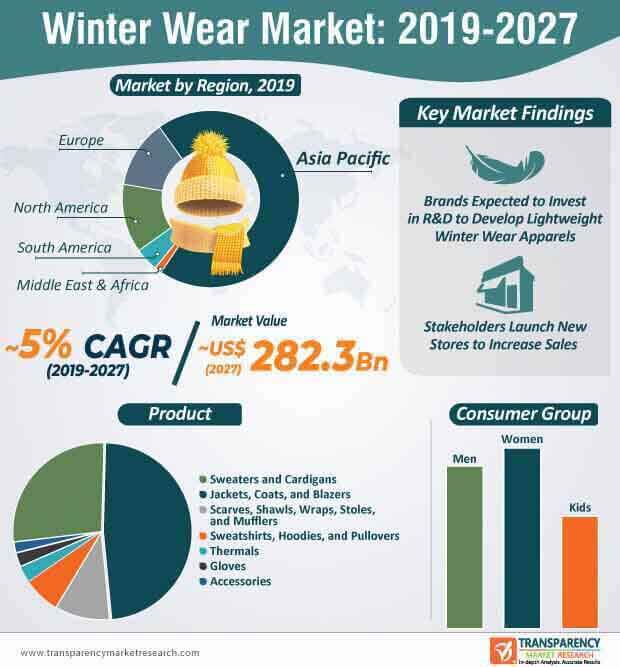
Innovations, evolving consumer preferences, and research & development activities are expected to play a major role in influencing the growth of the winter wear market in the near future. While winter wear can be broadly classified as seasonal apparel in a majority of the regions worldwide, its demand is significantly higher in prominent cold nations, including the U.S., Canada, the U.K., Greenland, Iceland, and Finland. Brands operating in the winter wear market are expected to manufacture new winter wear products including cardigans, sweaters, coats, blazers, hoodies, and thermal clothes, among others using new technologies and materials. Major established and new players in the current winter wear market landscape are largely investing resources in product development activities. Current trends, particularly in regions such as Europe and North America suggest that companies are also focusing on the sustainability of the product, as social and environmental issues have gained significant momentum in the past few years.
Apart from pricing strategies, brands are continually focusing on various aspects such as material sourcing, choice of fabric, and transparency to improve customer loyalty and position in the highly competitive winter wear market. As more number of companies continue to leverage the developments in fabric and insulation technology to improve the quality of their products, the demand for winter wear is growing at a steady rate worldwide. The global winter wear market is expected to reach a value of ~US$ 282.3 Bn by the end of 2027, as uptake for winter wear manufactured using next-generation fabric with improved insulation and heat retention properties continues.

Request a sample to get extensive insights into the Winter Wear Market
Brands Tap into Spacesuit Technology to Develop Winter Wear Products
Climate change is playing a significant role in the expansion of the winter wear market. In anticipation of cooler winters and recording-breaking winter temperatures, several companies are eyeing novel technologies to improve the quality and efficiency of their products. Trends in the winter wear market suggest that, as temperatures start declining, sales via retail and online channels increase. In the current scenario, brands in the winter wear market landscape are focusing their efforts on achieving a higher thermal value for their products. For instance, in November 2018, Oros Apparel introduced Solarcore insulation and leveraged the advantages of space technology to develop one of the winters wear warmest jackets. The company made use of the aerogel material technology that was primarily used to develop NASA spacesuits, to manufacture innovative winter wear apparel.
Similarly, Supield Inc. announced the launch of the Kistler Aerogel Jacket in which the aerogel technology is used to develop one of the thinnest winter wear jackets. Within the winter wear market, the jackets, coats, and blazers product segment is expected to reach a value of ~US$ 134 Bn and account for ~47% of the market share by the end of 2027.
To understand how our report can bring a difference to your business strategy, Ask for a brochure
Changing Consumer Trends Dictate Product Attributes
Manufacturers operating in the winter wear market are taking into account the evolving consumer trends while developing new winter wear products. Current trends suggest a growing focus toward the manufacturing of comfortable, lightweight, and supple jackets by tapping into advancements in fabric technology. For instance, Vroom introduced a cutting-edge technology that is likely to enable players in the winter wear market to develop lightweight jackets using a single layer of breathable textile. This recent advancement is expected to gain the same amount of traction as that of the Gore-Tex jacket, which was introduced in the mid-1970s. The new technology introduced by Vroomi could be a major step away from conventional layering systems and weatherproof shells in winter wear apparel with better features.
Companies in the winter wear market landscape are highly inclined toward improving the outworn technology and expand their product portfolio. For instance, in January 2019, North Face revealed a breathable waterproof material, which, according to the company, will redefine the future of technical fabrics. The new material was developed using Nanospinning technology with which the company strives to manufacture gloves, tents, and jackets.
Read Our Latest Press Release:





